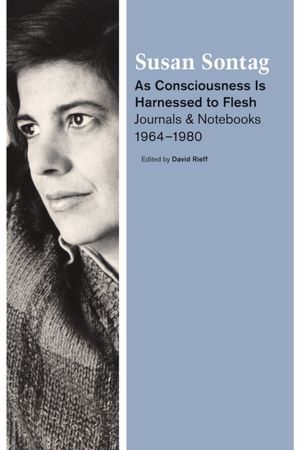
As Consciousness is Harnessed to Flesh:
Journals and Notebooks, 1964-1980
By Susan Sontag, edited by David Rieff
(Farrar, Straus and Giroux)
In the three years since “Reborn,” the first volume of Susan Sontag’s journals and notebooks, was published, at least three more books about the literary titan have appeared, notably Sigrid Nunez’s 2011 memoir, “Sempre Susan.”
Although Nunez’s reminiscences ― centering primarily on the brief time she lived with Sontag and her son, David Rieff, in the mid-’70s ― are filled with intimate, candid and often unflattering observations about the writer, nothing compares with going to the source directly.
The second of three volumes, “As Consciousness Is Harnessed to Flesh,” spans the years of Sontag’s most prodigious output and her greatest intellectual influence, including the 1966 publication of her first volume of essays, the landmark “Against Interpretation,” and the equally influential “Illness as Metaphor,” a 1978 treatise inspired by her first bout with breast cancer.
Though there are passing references to these and other works in this volume ― and plenty of lengthy, piercing disquisitions on politics, philosophy, art and literature ― “As Consciousness” reveals Sontag as plagued by doubt and despair, a maker of self-exhorting to-do lists.
“Her heart was one often broken, and much of this volume is the elaboration of romantic loss,” Rieff, editor of his mother’s journals, notes in the Preface.
Indeed the first entry, dated May 5, 1964, finds Sontag grieving over her four-year relationship with playwright Maria Irene Fornes, which had ended in 1963. “I don’t really accept the change in Irene. I think I can reverse it ― by explaining, by demonstrating that I am good for her,” Sontag says.
Her propensity for near-masochistic self-abnegation while in love is painfully detailed in several lengthy entries from 1970, when she was involved with an Italian aristocrat and former heroin addict called Carlotta here. “I must be strong, permissive, unreproachful, capable of joy (independently of her), able to take care of my own needs (but playing down my ability, or wish, to take care of hers). ... I cannot ever show her all my weakness,” Sontag writes.
That directive ― “I must” ― recurs throughout “As Consciousness,” whether as a list of “Essays still to write” or a roster of goals for greater self-discipline, including “I will try to confine my reading to the evening. (I read too much ― as an escape from writing.)”
Yet moments of self-regard ― assessments closer in spirit to Sontag’s imperious, confident public image ― also punctuate the journals. “I do like myself. I always have. ... It’s just that I don’t think other people will like me. And I ‘understand’ their point of view. But ― if I were other people ― I’d like me a lot,” Sontag notes with peculiar logic. But a mere four lines later, she returns to the journal’s dominant, rueful tone, repelled by her own needs and determined to never seem weak: “I vow not to make a fool of myself.” (MCT)








